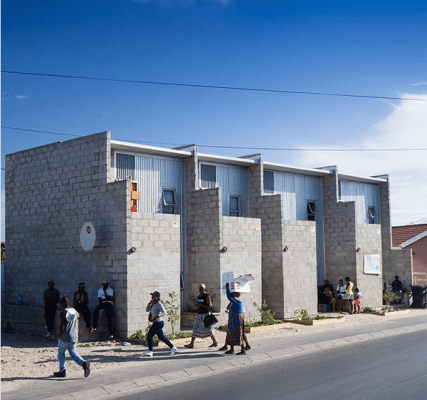Product Description
The Empower Shack is a dwelling designed by Urban Think Tank in collaboration with Ikhayalami. It is made out of materials such as wood and iron sheeting, and can be self-built. It has two storeys, but it could be expanded to three. The vertical building has a smaller footprint than typical informal houses.
The project aims to be scalable and applicable to answer South Africa’s housing shortage. It is on its pilot phase focusing within BT Section of Khayelitsha, Cape Town.
The project also focuses on developing the neighborhoods, and planning for infrastructure such as public spaces, roads and courtyards. It aims to be comprehensive, covering participatory spatial planning, ecological landscape management and integrated livelihoods programming.
*Please note that building designs are being included as “products” in the Habitat Sector of the Solutions Library to allow readers to learn from how projects were designed and constructed and how they are serving the occupants, whether effective or ineffective.
Target Users (Target Impact Group)
Distributors / Implementing Organizations
Urban Think Tank (UTT) in partnership with Ikhayalami
Manufacturing/Building Method
The houses are self-built by the residents. The framework is developed using computational tools that maximize the user's input and transparency. It generates layouts according to individual and community preferences, and municipal frameworks.
Intellectural Property Type
Select Type
User Provision Model
The units are facilitated through Ikhayalami. The organization also negotiates the loan terms and repayments, depending on each household.
Distributions to Date Status
The first prototype was made in 2013, followed by four units in 2014, and sixteen in 2017.
Unique Design (Yes/No)
No
Intended number of occupants (#)
5 – 8 occupants
Duration of construction (days)
Unknown
Footprint area (m²)
Number of storeys
Material composition
Flammable flash point temperature (ºC)
Unknown
Thermal insulating capacity (m²*K/W)
Iron sheeting is not a good insulator; however, South Africa’s warm climate allows households to use this material without insulation.
Maximum wind speed (km/h)
Unknown
Structural Occupancy Category
II
Seismic Design Category
II
Suitable Climates
Temperate and tropical
Design Specifications
The design is a two-storey building with a sanitation core, balcony, living area, kitchen and bedrooms. The designers are experimenting with alternative configurations to adapt to the needs of different households.
Technical Support
Ikhayalami coordinates the process and provides assitance during construction.
Replacement Components
A rusted iron sheet could be replaced.
Lifecycle
Unknown
Manufacturer Specified Performance Parameters
The units should be affordable, easy to transport, simple and quick to build, and an upgrade to living conditions. The project also aims to improve the community infrastructure so that it is easier to provide power, sanitation, clean water and access to emergency vehicles, as well as reducing the risk of fires.
Vetted Performance Status
Unknown
Safety
The user will be subjected to all the risks associated with a construction site: heights, tools, power tools, heavy objects, etc.
Academic Research and References
Miao, Y., Koenig, R., Bus, P., Chang, M., Chirkin, A., Treyer, L., 2017, Empowering Urban Design Prototyping: A Case Study in Cape Town with Interactive Computational Synthesis Methods. Proceedings of the 22nd International Conference CAADRIA, Suzhou, China, April, 2017, pp. 407-417
Compliance with regulations
Unknown, though the project is being done in cooperation with the government.
Other Information
The design was nominated for the Royal Institute of British Architects (RIBA) International Prize.
The City of Cape Town signed a memorandum of understanding with Ikhayalami where the former would oversee the installation of water, sanitation, and road infrastructure while the latter was responsible for organizing the community, facilitation, and involvement of all stakeholders in the project.
Get more information about Solutions Library and its features.
Learn MoreHave thoughts on how we can improve?
Give Us Feedback